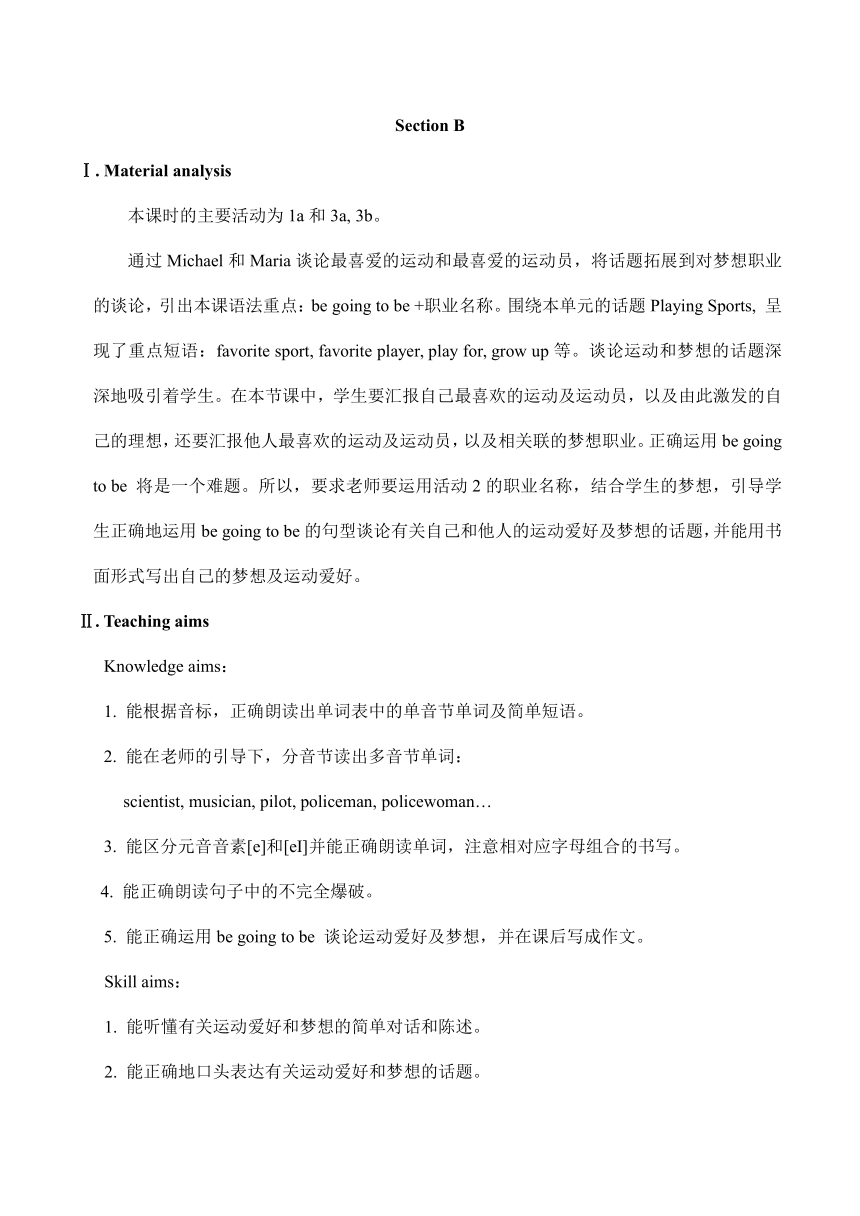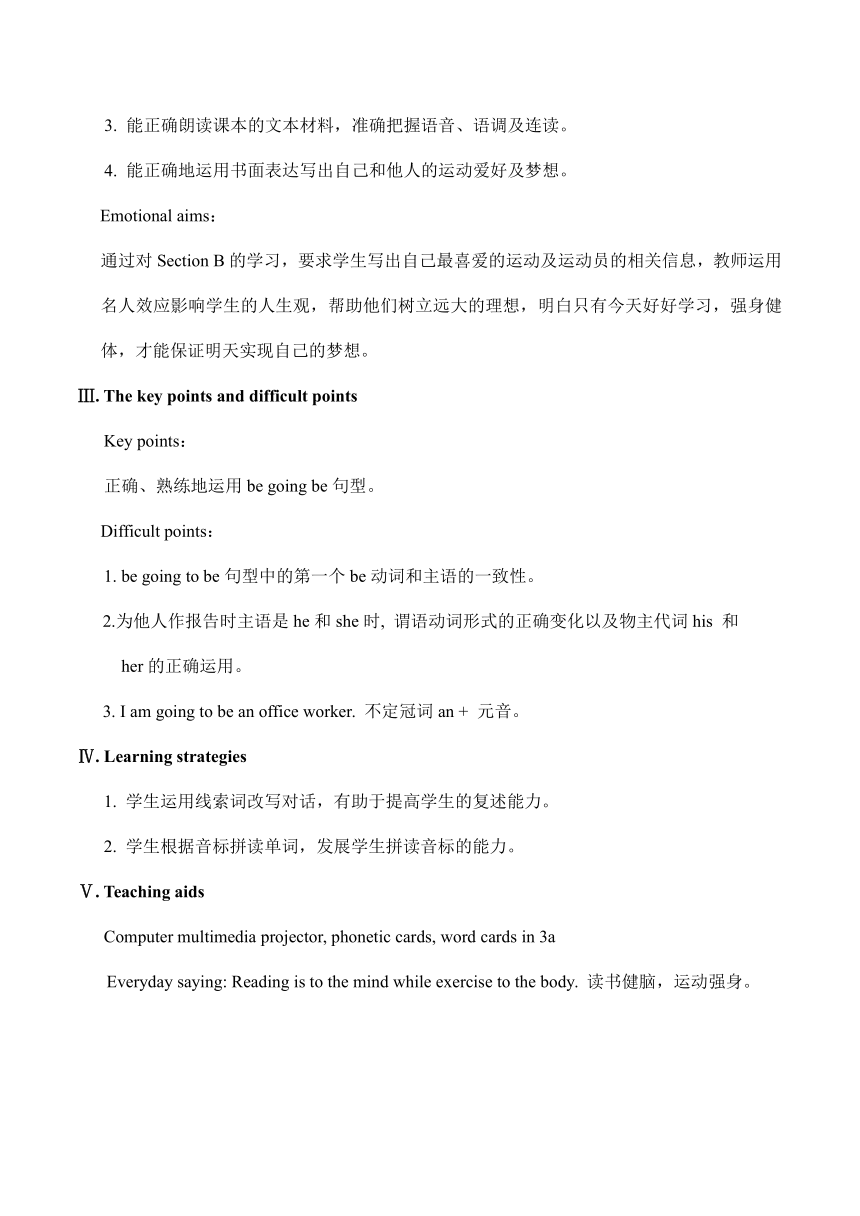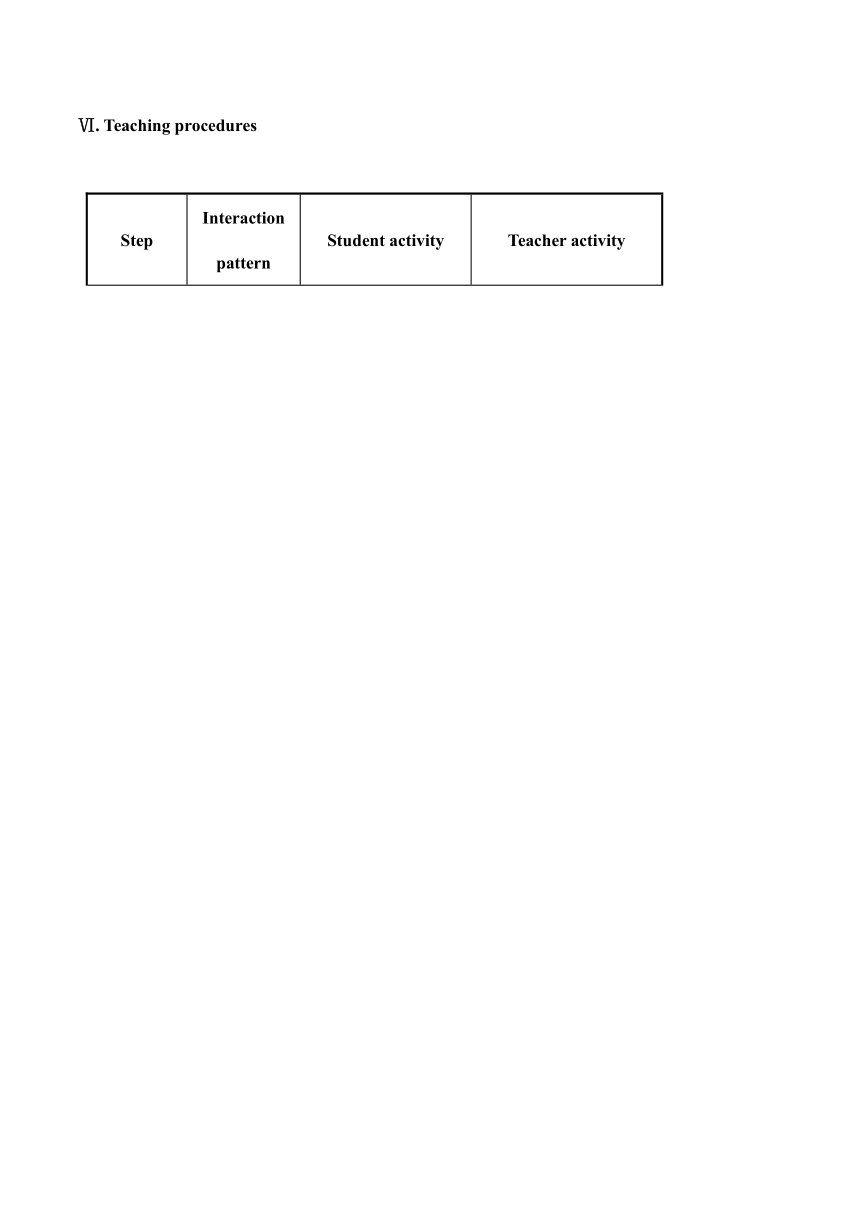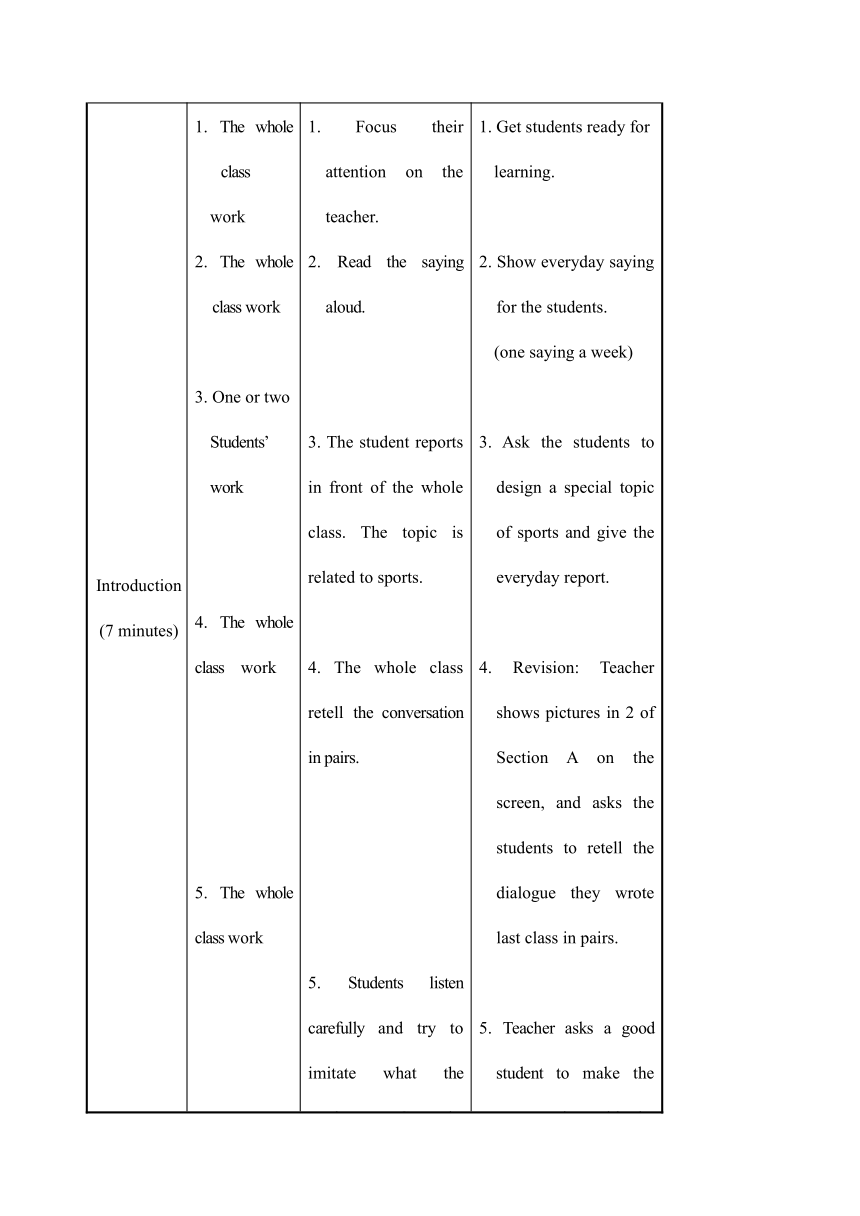八上Unit 1 Topic 1 I'm going to play basketball Section B教案
文档属性
| 名称 | 八上Unit 1 Topic 1 I'm going to play basketball Section B教案 |  | |
| 格式 | doc | ||
| 文件大小 | 62.5KB | ||
| 资源类型 | 教案 | ||
| 版本资源 | 仁爱科普版 | ||
| 科目 | 英语 | ||
| 更新时间 | 2020-12-01 10:41:46 | ||
图片预览




文档简介
Section B
Ⅰ. Material analysis
本课时的主要活动为1a和3a, 3b。
通过Michael和Maria谈论最喜爱的运动和最喜爱的运动员,将话题拓展到对梦想职业的谈论,引出本课语法重点:be going to be +职业名称。围绕本单元的话题Playing Sports, 呈现了重点短语:favorite sport, favorite player, play for, grow up等。谈论运动和梦想的话题深深地吸引着学生。在本节课中,学生要汇报自己最喜欢的运动及运动员,以及由此激发的自己的理想,还要汇报他人最喜欢的运动及运动员,以及相关联的梦想职业。正确运用be going to be 将是一个难题。所以,要求老师要运用活动2的职业名称,结合学生的梦想,引导学生正确地运用be going to be的句型谈论有关自己和他人的运动爱好及梦想的话题,并能用书面形式写出自己的梦想及运动爱好。
Ⅱ. Teaching aims
Knowledge aims:
1. 能根据音标,正确朗读出单词表中的单音节单词及简单短语。
2. 能在老师的引导下,分音节读出多音节单词:
scientist, musician, pilot, policeman, policewoman…
3. 能区分元音音素[e]和[eI]并能正确朗读单词,注意相对应字母组合的书写。
4. 能正确朗读句子中的不完全爆破。
5. 能正确运用be going to be 谈论运动爱好及梦想,并在课后写成作文。
Skill aims:
1. 能听懂有关运动爱好和梦想的简单对话和陈述。
2. 能正确地口头表达有关运动爱好和梦想的话题。
3. 能正确朗读课本的文本材料,准确把握语音、语调及连读。
4. 能正确地运用书面表达写出自己和他人的运动爱好及梦想。
Emotional aims:
通过对Section B的学习,要求学生写出自己最喜爱的运动及运动员的相关信息,教师运用名人效应影响学生的人生观,帮助他们树立远大的理想,明白只有今天好好学习,强身健体,才能保证明天实现自己的梦想。
Ⅲ. The key points and difficult points
Key points:
正确、熟练地运用be going be句型。
Difficult points:
1. be going to be句型中的第一个be动词和主语的一致性。
2.为他人作报告时主语是he和she时, 谓语动词形式的正确变化以及物主代词his 和
her的正确运用。
3. I am going to be an office worker. 不定冠词an + 元音。
Ⅳ. Learning strategies
1. 学生运用线索词改写对话,有助于提高学生的复述能力。
2. 学生根据音标拼读单词,发展学生拼读音标的能力。
Ⅴ. Teaching aids
Computer multimedia projector, phonetic cards, word cards in 3a
Everyday saying: Reading is to the mind while exercise to the body. 读书健脑,运动强身。
Ⅵ. Teaching procedures
Step Interaction pattern Student activity Teacher activity
Introduction (7 minutes) 1. The whole class?
work
2. The whole class work
3. One or two
Students work
4. The whole class work
5. The whole class爓ork 1. Focus their attention on the teacher.
2. Read the saying aloud.
3. The student reports in front of the whole class. The topic is related to sports.
4. The whole class retell the conversation in pairs.
5. Students listen carefully燼nd try to imitate what the teacher says. Guess爐he meanings of the new爓ords.
1. Get students ready for
learning.
2. Show everyday saying for the students.
(one saying a week)
3. Ask the students to design a special topic of sports and give the everyday report.
4. Revision: Teacher shows pictures in 2 of Section A on the screen, and asks the students to retell the dialogue they wrote last class in pairs.
5. Teacher asks a good student to make the conversation with the teacher, to learn 揑抦 going to be a 厰 and the new word 損layer.
T: Are you going to join the school rowing club?
S: Yes, I am. What about you?
T: I抦 going to join the school table tennis
Presentation (6 minutes) 1. The whole class
work
2.The whole class
work
3.The whole class
work
4. The whole class
work
1. Students answer together.
I抦 going to be a
rowing player.
I抦 going to be a
tennis player.
I抦 going to be a table tennis player.
2. Students listen carefully, and find the sentences.揑 am going to be a
basketball player.
揑 like Yao Ming best.
3. Students listen carefully and try to understand the meaning of
揻avorite with the
help of their own
memory. After listening, they should find out the answers to the two questions 揃asketball,
of course. Me , too. 揟hat抯 OK.
4. Listen and complete the table in 1b.
1. Teacher shows 3 pictures in 2 of Section A on the screen, with new phrases under each picture: a rowing player, a tennis player, a table tennis player. The teacher asks: What are you going to be? The students answer according to the pictures.
2. Start on 1b.
Teacher: I have a dream. I am going to be a table tennis player. Michael also has a dream, and let抯 listen to 1a and find out: What is Michael going to be? Who is Michael抯
favorite player? Let抯 listen.
3. Go on with 1b.
Teacher says 揑 like table tennis best. My favorite sport is table tennis. to help students understand the meaning of 揻avorite, then asks students two questions: ①What is
Michael’s favorite sport? ②What is Maria’s favorite sport?
Consolidation (15 minutes) 1. The whole
class work
2. The whole
class work
3. Pair work
4. Individual work
5. The whole class
work and
individual work
6. Several students
work
7. Several students牋
work 1. Students read sentence by sentence, imitating the pronunciation.
2. Students try to follow the speed.
3. Students read 1a in
pairs, trying to read correctly and fluently.
4. Students read 1a
individually as quickly as they can.
5. Students underline the language points in the text book, and finish the exercises in summary爋n the computer screen.
6. The first six excellent
students write the
answers of 1c on the
blackboard.
7. Volunteers correct the
essays. Students should
develop the habit of
checking by themselves.
1. Read 1a. Teacher plays the recording of 1a sentence by sentence.
2. Teacher plays the
recording without stopping.
3.Teacher offers students 1 or 2 minutes to read 1a in pairs.
4. Design a competition:
To see who can read the fastest in class.
5. Explain 1a.
(1) favorite player;
(2) 搒omething and
揳nything;
(3) “play for” and “play
against”;
(4) prep “like” and verb “like”;
(5)“men compound words”;
(6) “when” clause.
6. Finish1c: Teacher limits the
time for the students to
finish1c, and the first six
students write their essays
“My…” on
the blackboard.
7. Correct the essays: Teacher
asks another 6 volunteers to
correct the essays.燭eacher
Practice (10 minutes) 1. The whole
class work
2. The whole
class work
3.Group work
4.Group work
5. The whole
class work
6. Several
students work
7. Several
students work
8. The whole
class work
9. The whole class
work
10. Pair work
11. The whole
class work
12. The whole
class work
13. Group work
1. Students read the words individually, asking for help when necessary.
2. Students read and pay
more attention to the
vowel phonemes.
3. Students read in groups.
4. Students ask and answer in pairs as quickly as they can.
梂hat are you going to be when you grow up?
桰抦 going to be a / an
5. Students read together.
6. Students read one by one.
7. Six Member Bs read
the words one by one.
8. Students read together, paying attention to the
sound of /e/ and /eI /.
9. Students pay attention to
the changing of /eI /.
10. One student reads, while theother listens and judges if it is right.
11. Students read together.
12. Students read after the recording, trying to imitate the sound.
13. Find the one who
can抰 read and help
him / her.
1. Teacher offers 2 or 3
minutes to the students to read all the words.
2. Teacher encourages students to read the phonetic syllable
phoneme by phoneme.
3. Teacher asks students to read 2 word by word.
4. Relaxing time. Practice the reviewing words.
5. Teacher shows phonetic cards /e/ and /eI/.
6. Teacher asks the students to read /e/ and /eI/ one by one.
7. Teacher shows word
cards, calling Member B from爀ach group to read one by one.
8. Teacher plays the
recording of 3a .
9. Teacher shows 搉ext
weekend. Read 搉ext and 搘eekend敔separately,
and then read together.
10. Teacher lets students read 3b in pairs.
11. Teacher leads the
students to read.
12. Teacher plays the
recording.
13. Teacher encourages
students to read 3b in
Production (7 minutes)
1.燭he whole class
work
2. Individual work
3. Individual work
1. Students summarize
Section B together
with the teacher.
2. Students finish writing
two essays after class.
3. Students preview
Section C after class.
Finish1d:
1. Teacher summarizes.
2.Teacher assigns 1d as
homework. They should
finish 2 tasks.
(1) Write something about your favorite sport, your favorite sports stars and your dream.
(2) Write something about other抯 favorite sport, other抯 favorite sports stars and other’s dream.
3. Prepare for the learning of
Teaching Reflection Students are very interested in talking about their favorite sports stars,but it’s difficult for them to say their different dreams when they grow up.
Ⅶ. Blackboard design
Unit 1 Playing Sports
Ⅰ. Material analysis
本课时的主要活动为1a和3a, 3b。
通过Michael和Maria谈论最喜爱的运动和最喜爱的运动员,将话题拓展到对梦想职业的谈论,引出本课语法重点:be going to be +职业名称。围绕本单元的话题Playing Sports, 呈现了重点短语:favorite sport, favorite player, play for, grow up等。谈论运动和梦想的话题深深地吸引着学生。在本节课中,学生要汇报自己最喜欢的运动及运动员,以及由此激发的自己的理想,还要汇报他人最喜欢的运动及运动员,以及相关联的梦想职业。正确运用be going to be 将是一个难题。所以,要求老师要运用活动2的职业名称,结合学生的梦想,引导学生正确地运用be going to be的句型谈论有关自己和他人的运动爱好及梦想的话题,并能用书面形式写出自己的梦想及运动爱好。
Ⅱ. Teaching aims
Knowledge aims:
1. 能根据音标,正确朗读出单词表中的单音节单词及简单短语。
2. 能在老师的引导下,分音节读出多音节单词:
scientist, musician, pilot, policeman, policewoman…
3. 能区分元音音素[e]和[eI]并能正确朗读单词,注意相对应字母组合的书写。
4. 能正确朗读句子中的不完全爆破。
5. 能正确运用be going to be 谈论运动爱好及梦想,并在课后写成作文。
Skill aims:
1. 能听懂有关运动爱好和梦想的简单对话和陈述。
2. 能正确地口头表达有关运动爱好和梦想的话题。
3. 能正确朗读课本的文本材料,准确把握语音、语调及连读。
4. 能正确地运用书面表达写出自己和他人的运动爱好及梦想。
Emotional aims:
通过对Section B的学习,要求学生写出自己最喜爱的运动及运动员的相关信息,教师运用名人效应影响学生的人生观,帮助他们树立远大的理想,明白只有今天好好学习,强身健体,才能保证明天实现自己的梦想。
Ⅲ. The key points and difficult points
Key points:
正确、熟练地运用be going be句型。
Difficult points:
1. be going to be句型中的第一个be动词和主语的一致性。
2.为他人作报告时主语是he和she时, 谓语动词形式的正确变化以及物主代词his 和
her的正确运用。
3. I am going to be an office worker. 不定冠词an + 元音。
Ⅳ. Learning strategies
1. 学生运用线索词改写对话,有助于提高学生的复述能力。
2. 学生根据音标拼读单词,发展学生拼读音标的能力。
Ⅴ. Teaching aids
Computer multimedia projector, phonetic cards, word cards in 3a
Everyday saying: Reading is to the mind while exercise to the body. 读书健脑,运动强身。
Ⅵ. Teaching procedures
Step Interaction pattern Student activity Teacher activity
Introduction (7 minutes) 1. The whole class?
work
2. The whole class work
3. One or two
Students work
4. The whole class work
5. The whole class爓ork 1. Focus their attention on the teacher.
2. Read the saying aloud.
3. The student reports in front of the whole class. The topic is related to sports.
4. The whole class retell the conversation in pairs.
5. Students listen carefully燼nd try to imitate what the teacher says. Guess爐he meanings of the new爓ords.
1. Get students ready for
learning.
2. Show everyday saying for the students.
(one saying a week)
3. Ask the students to design a special topic of sports and give the everyday report.
4. Revision: Teacher shows pictures in 2 of Section A on the screen, and asks the students to retell the dialogue they wrote last class in pairs.
5. Teacher asks a good student to make the conversation with the teacher, to learn 揑抦 going to be a 厰 and the new word 損layer.
T: Are you going to join the school rowing club?
S: Yes, I am. What about you?
T: I抦 going to join the school table tennis
Presentation (6 minutes) 1. The whole class
work
2.The whole class
work
3.The whole class
work
4. The whole class
work
1. Students answer together.
I抦 going to be a
rowing player.
I抦 going to be a
tennis player.
I抦 going to be a table tennis player.
2. Students listen carefully, and find the sentences.揑 am going to be a
basketball player.
揑 like Yao Ming best.
3. Students listen carefully and try to understand the meaning of
揻avorite with the
help of their own
memory. After listening, they should find out the answers to the two questions 揃asketball,
of course. Me , too. 揟hat抯 OK.
4. Listen and complete the table in 1b.
1. Teacher shows 3 pictures in 2 of Section A on the screen, with new phrases under each picture: a rowing player, a tennis player, a table tennis player. The teacher asks: What are you going to be? The students answer according to the pictures.
2. Start on 1b.
Teacher: I have a dream. I am going to be a table tennis player. Michael also has a dream, and let抯 listen to 1a and find out: What is Michael going to be? Who is Michael抯
favorite player? Let抯 listen.
3. Go on with 1b.
Teacher says 揑 like table tennis best. My favorite sport is table tennis. to help students understand the meaning of 揻avorite, then asks students two questions: ①What is
Michael’s favorite sport? ②What is Maria’s favorite sport?
Consolidation (15 minutes) 1. The whole
class work
2. The whole
class work
3. Pair work
4. Individual work
5. The whole class
work and
individual work
6. Several students
work
7. Several students牋
work 1. Students read sentence by sentence, imitating the pronunciation.
2. Students try to follow the speed.
3. Students read 1a in
pairs, trying to read correctly and fluently.
4. Students read 1a
individually as quickly as they can.
5. Students underline the language points in the text book, and finish the exercises in summary爋n the computer screen.
6. The first six excellent
students write the
answers of 1c on the
blackboard.
7. Volunteers correct the
essays. Students should
develop the habit of
checking by themselves.
1. Read 1a. Teacher plays the recording of 1a sentence by sentence.
2. Teacher plays the
recording without stopping.
3.Teacher offers students 1 or 2 minutes to read 1a in pairs.
4. Design a competition:
To see who can read the fastest in class.
5. Explain 1a.
(1) favorite player;
(2) 搒omething and
揳nything;
(3) “play for” and “play
against”;
(4) prep “like” and verb “like”;
(5)“men compound words”;
(6) “when” clause.
6. Finish1c: Teacher limits the
time for the students to
finish1c, and the first six
students write their essays
“My…” on
the blackboard.
7. Correct the essays: Teacher
asks another 6 volunteers to
correct the essays.燭eacher
Practice (10 minutes) 1. The whole
class work
2. The whole
class work
3.Group work
4.Group work
5. The whole
class work
6. Several
students work
7. Several
students work
8. The whole
class work
9. The whole class
work
10. Pair work
11. The whole
class work
12. The whole
class work
13. Group work
1. Students read the words individually, asking for help when necessary.
2. Students read and pay
more attention to the
vowel phonemes.
3. Students read in groups.
4. Students ask and answer in pairs as quickly as they can.
梂hat are you going to be when you grow up?
桰抦 going to be a / an
5. Students read together.
6. Students read one by one.
7. Six Member Bs read
the words one by one.
8. Students read together, paying attention to the
sound of /e/ and /eI /.
9. Students pay attention to
the changing of /eI /.
10. One student reads, while theother listens and judges if it is right.
11. Students read together.
12. Students read after the recording, trying to imitate the sound.
13. Find the one who
can抰 read and help
him / her.
1. Teacher offers 2 or 3
minutes to the students to read all the words.
2. Teacher encourages students to read the phonetic syllable
phoneme by phoneme.
3. Teacher asks students to read 2 word by word.
4. Relaxing time. Practice the reviewing words.
5. Teacher shows phonetic cards /e/ and /eI/.
6. Teacher asks the students to read /e/ and /eI/ one by one.
7. Teacher shows word
cards, calling Member B from爀ach group to read one by one.
8. Teacher plays the
recording of 3a .
9. Teacher shows 搉ext
weekend. Read 搉ext and 搘eekend敔separately,
and then read together.
10. Teacher lets students read 3b in pairs.
11. Teacher leads the
students to read.
12. Teacher plays the
recording.
13. Teacher encourages
students to read 3b in
Production (7 minutes)
1.燭he whole class
work
2. Individual work
3. Individual work
1. Students summarize
Section B together
with the teacher.
2. Students finish writing
two essays after class.
3. Students preview
Section C after class.
Finish1d:
1. Teacher summarizes.
2.Teacher assigns 1d as
homework. They should
finish 2 tasks.
(1) Write something about your favorite sport, your favorite sports stars and your dream.
(2) Write something about other抯 favorite sport, other抯 favorite sports stars and other’s dream.
3. Prepare for the learning of
Teaching Reflection Students are very interested in talking about their favorite sports stars,but it’s difficult for them to say their different dreams when they grow up.
Ⅶ. Blackboard design
Unit 1 Playing Sports
同课章节目录
- Unit 1 Playing Sports
- Topic 1 I'm going to play basketball.
- Topic 2 I'll kick you the ball again.
- Topic 3 The school sports meet is coming.
- Unit 2 Keeping Healthy
- Topic 1 You should brush your teeth twice a day.
- Topic 2 I must ask him to give up smoking.
- Topic 3 Must we exercise to prevent the flu?
- Unit 3 Our Hobbies
- Topic 1 What's your hobby?
- Topic 2 What sweet music!
- Topic 3 What were you doing at this time yesterday
- Unit 4 Our World
- Topic 1 What's the strongest animal on the farm?
- Topic 2 How can we protect ourselves from the eart
- Topic 3 The Internet makes the world smaller.
